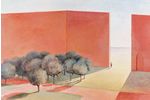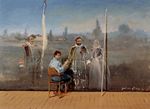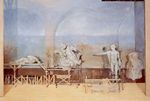|
Giuliano Gèleng: migrazione e mutazione della pittura
(una strana biografìa)
L'arte è una materia impalpabile che si dilata sulla vita
e la schiude su dimensioni profonde dell'essere e dell'esistente,
del trascendente, e più che essere posseduta, possiede. Ma
la pittura è una tecnica che può spesso portare all'arte e
altrettanto spesso, in qualche modo, si può possedere. Alcune
volte si tratta di un possesso ereditario, una trasmigrazione
di geni, un discendere di padre in figlio, e non c'è dubbio
che nella famiglia Gèleng questa teoria si dimostri in tutta
la sua evidenza.
Giuliano, infatti, è figlio di Rinaldo, pittore e ritrattista
raffìnatissimo tra i più stimati intemazionalmente di questi
ultimi decenni, così come è pronipote di Otto von Gèleng a
sua volta paesaggista colto e sensibile.

Otto von Gèleng, tedesco, visse buona parte della sua lunga
vita in Italia, a cavallo tra otto e novecento, attratto dal
mistero del paesaggio, dallo svelarsi nella pittura di quel
sentimento struggente di eterno che si nasconde nella realtà
delle cose e della natura: in questa difficoltosa semplicità,
risolta con la leggerezza della pittura, i Gèleng lasciano
la loro più importante eredità. È un modo di essere nel mondo.
In questo mondo Giuliano Gèleng nasce e cresce, matura al
fianco del padre, tra gli odori dei colori e dei solventi,
fra i pennelli e le tele, in un universo di immagini. Universo
che cresce con l'incontro,
Giuliano è giovanissimo, con Federico Fellini.
Compiamo un salto all'indietro nel tempo e scopriamo, intomo
agli anni quaranta, Rinaldo e Federico' che ritraggono avventori
nei ristoranti: strana pratica, ma è proprio questa inclinazione
che tende a sintetizzare l'umanità attraverso il ritratto,
l'inconscio bisogno di imbalsamare la realtà duratura della
"persona" nella straordinaria facoltà di leggere un volto,
che condensa il desiderio di comunicare una bellezza diffìcile
e possibile della vita nei differenti linguaggi poetici di
Fellini e Rinaldo Gèleng. Le facce, nessuno dimenticherà le
facce dei film di Fellini o i ritratti di Rinaldo Gèleng.

Qualche anno dopo sono separati da strade professionali diverse
ma si ritrovano negli anni sessanta e pian piano, spinti dalle
"affinità elettive", decidono di tornare a collaborare: Fellini
sta lavorando a "I Clowns" e Rinaldo dipinge una serie di
personaggi; con lui sono i due figli Antonello e Giuliano.
Stabilito questo contatto, i Gèleng collaboreranno praticamente
a tutti i film del Maestro, e Giuliano in modo particolare
senza mai scostarsi dalsuo ruolo di pittore (mentre Antonello,
ad esempio, si dedicherà soprattutto alle scenografìe). Anche
in questo caso Giuliano assorbe particelle dall'immaginario
felliniano e la creatività, spesso si "attacca". Giuliano
Gèleng compie la parabola che tutti i giovani appassionati
di pittura, chi più chi meno, intraprendono: Accademia di
Belle Arti, passione per la tecnica, per il linguaggio, e
l'insegnamento. Ebbene si, c'è un momento nella vita in cui
si crede anche nella scuola.
L'Accademia di Roma vede Giuliano frequentare il corso di
Guttuso anche se la latitanza del celebre pittore fa del suo
assistente Piero Guccione il vero docente e Guccione, occorre
ricordarlo, è un ottimo pittore. Anche da Guccione, Giuliano,
assorbe la coscienza della pittura come strumento di osservazione
della realtà libero da ideologie preconcette.
Guccione è un pittore "di sinistra" ma raramente fa della
pittura uno strumento ideologico e nelle sue escursioni nei
paesaggi, nelle periferie, tra macerie e rottami, si legge
come le idee non possono sussistere separate dalle cose stesse.
Finita l'Accademia, Giuliano prende la strada dell'insegnamento
che persegue con passione prima a Roma poi a Perugia ma la
burocrazia, l'ottusità, la disorganizzazione e la pedanteria
dei nostri apparati scolastici finiranno per sfinirlo e per
consegnarlo unicamente alla pittura.

La biografia di un pittore è comunque nelle tracce che portano
alla formazione della sua poetica; molto esiste già prima,
abbiamo seguito le migrazioni, e tutto cresce, si forma, nelle
mutazioni registrate nelle opere dal gesto, dalla trascrizione
automatica e cosciente dell'autore sulle pagine bianche della
comunicazione artistica.
|
Giuliano Gèleng: migration and mutation in art (a strange
biography).

Art is a wisp-like matter which swells out on life and opens
it to the depths of one's being and existing, to a deeply
rooted transcendent dimension and moreover, art would rather
possess than be possessed. Painting is a technique which can
often lead to art and can be some how possessed. Sometimes
this can be seen as a hereditary possession, it can be considered
like something similar to a transmigration of genes, to what
passes on from parent to child, and there is hardly any doubt
about the truthfulness of this theory especially if we think
of the Gèlengs.
In fact, Giuliano is Rinaldo Gèleng's son, who is considered
as a very refined artist and as one of the most highly esteemed
pointer and portraitist of the last decades.
Giuliano Gèleng's great uncle, Otto von Gèleng, was on his
turn a cultivated and sensitive landscape pointer. Between
the nineteenth and the twentieth century, the German Otto
von Gèleng spent much of his long life in Italy. He was attracted
by the mystery of the landscape and by that eternal and melting
feeling which hides itself in the reality of the external
world and of Nature and which reveals itself in the art of
painting: the Gèlengs' most important inheritance lies in
this puzzling simplicity which is resolved through the softness
of painting. It is the art of being part of the world. And
this was the world where Giuliano Gèleng was born and grew
up: his personality matured by his father's side, he was fed
on a universe of images through brushes and canvas, through
the smell of solvents and paints...This fabulous universe
grew even richer when the young Giuliano met Federico Fellini.

But now let's take a step backward to the forties: at that
time Rinaldo Gèleng and Federico used to depict customers
in restaurants: what a strange custom! And yet it was just
this tendency to sum up humanity through portraits and this
unconscious need to embalm the long-lasting reality of a "person"
through the, extraordinary capability of reading somebody's
countenance, which condensed the wish of conveying the possible
but hard beauty of life through the two different poetic languages
belonging to Fellini and to Rinaldo Gèleng.
Faces...: nobody could ever forget neither the ones depicted
in Fellini's films nor the ones in Rinaldo Gèleng's portraits.
A few years later they chose different professional paths,
but they met again during the Sixties and, driven by "elective
affinities", they decided to work together again. At that
time Fellini was filming "I Clowns" and Rinaldo started to
portrait a series of characters for him.
His sons Antonello and Giuliano were by his side. From that
moment on the Gèlengs would work together with the master
on his films, Giuliano would always cooperate without straying
away from his being a pointer (while Antonello would mostly
devote himself to the set-designing).
In this occasion too, Giuliano assimilated particles from
Fellini's imagination...creativity can become contagious".
Giuliano Gèleng walked along a path which is common to most
of the young people who are passionately fond of painting:
the Academy of Fine Arts, passion for technique, for language
and for teaching. Actually, there is a moment in life when
one believes in school too. By the Academy of Rome Giuliano
Gèleng attended a course held by Guttuso, but the famous pointer
went into hiding, so his assistant Piero Cucciane became the
active holder of the course and we should not forget that
he is an excellent pointer. In this occasion again, Giuliano
assimilated from Cucciane the consciousness of perceiving
painting as a preconceived ideologies free instrument, through
which one can observe reality. Cucciane is a "left-wing" painter,
but he seldom used painting as an ideological instrument and
by walking his landscapes, his outskirts, his ruins and wrecks
it is possible to grasp the conceit that ideas can not exist
apart from things themselves.
After having graduated from academy, Giuliano went in for
teaching first in Rome and then in Perugia, but he soon gave
up because of bureaucracy, bluntness, disorganization and
pedantry, which are often to be found in the institutions
of our country, so he finally decided to devote himself completely
to painting.
No doubt a painter's biography lies in those marks which bring
to the moulding of his poetics; much of this comes to life
previously as I wanted to show by following such migrations,
and then everything grows to maturity through such mutations
as witnessed on the paintings by the deed, by the conscious
and automatic transcription that the author carries out on
the blankpages of artistic communication.
|

